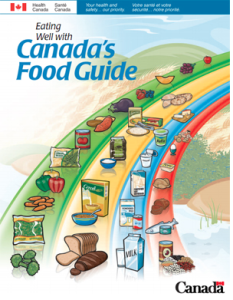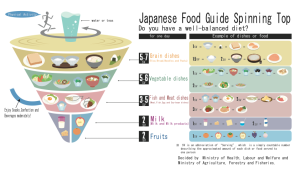Healthy Plate, Healthy You
If you look into nutritional guidelines from around the world, you will realize that almost every nation has their own unique version of the food guide. However, the hard part about most of them is translation into practice. After all, how do you eat the spinning top that is the Japanese food guide or the rainbow that is the Canadian food guide?

In reality, we all eat off plates. Therefore, the most important part about understanding any food guide is knowing how to transfer its messages into a healthy plate one can eat. After all, if we are what we eat, we better make our meals as healthy as they can be. Here are 5 easy tips on how to achieve this:
- Make half your plate vegetables and fruits. Make sure to eat dark-green and orange vegetables and fruits every day, along with other colour varieties. The different colours of vegetables and fruits come from their different nutrient contents. The more colourful you plate, the greater variety of nutrients you’re eating.
- Make at least half your grains whole grains. This will add more fibre to your diet and help to better balance out blood sugars. As well, whole grains will keep you fuller longer and are a great source of B-vitamins. Look for “whole grain” or “whole wheat” as the first ingredient on bread products or pasta, and make the switch from white rice to brown rice.
- Choose leaner meats, poultry, and vegetarian sources of protein more often. The marbling in meats is indicative of high saturated fat content. However, even without the visible streaks, certain cuts of meat can be high in fat that is hidden in between the animal’s muscle tissue. Choose meats that are labeled “lean” or “extra lean” or switch to poultry to cut down on the calories and fat. Choosing vegetarian sources of protein—such as tofu, beans, legumes, and nuts—can also help cut down on your daily calorie intake, while increasing daily fibre intake and still providing the necessary nutrients.
- Plate your food, eliminate distractions, and eat slowly. When eating straight out of containers or pots it’s easier to lose control of portion size and overeat. Furthermore, distractions such as television make paying attention to hunger and satiety cues more difficult. Since it takes 20 minutes for the stomach to signal the brain that food is present, it is particularly important to eat slowly and be vigilant of the body’s signals.
- Choose <1% dairy products. Lower fat dairy has the same quantity of calcium and other essential nutrient as their higher fat counterparts, but with a lower saturated fat and calorie content. To adjust for taste, start off by mixing your current milk with its lower part counterpart for a few weeks to help your taste buds adjust.
For more information on healthy eating and help with reaching your nutrition goals contact your local Registered Dietitian, Anna Gofeld, at the Form and Function clinic in Club Markham. Don’t wait another day, start eating healthy today!
